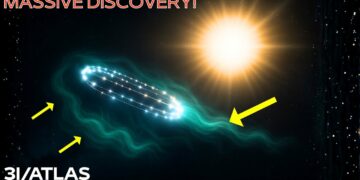NASA has reestablished contact with Voyager 1, humanity’s farthest spacecraft, located over 14 billion miles from Earth. The spacecraft is transmitting data that has left scientists puzzled, as it appears to be in an incomprehensible format, described by some as an “alien language.” This unexpected message hints at a mysterious object nearby in interstellar space, raising questions about its significance and potential to reshape our understanding of the cosmos. What does this enigmatic signal mean, and could it indicate something extraordinary?
The Launch of Voyager 1
On September 5, 1977, NASA launched Voyager 1 from Cape Canaveral, Florida, using a reliable Titan 3E rocket. This mission, part of the Voyager program alongside its twin, Voyager 2, aimed to explore the outer planets of our solar system. Equipped with cameras, spectrometers, and magnetometers, Voyager 1 was designed to study Jupiter and Saturn, taking advantage of a rare planetary alignment to travel efficiently without extra fuel. The successful launch marked a bold step in human exploration, with the spacecraft sending its first signals back to Earth, confirming its functionality. Voyager 1 carried the aspirations of scientists and explorers, becoming a symbol of human curiosity.
Voyager 1’s Mission to Jupiter and Saturn
Voyager 1 reached Jupiter in March 1979, capturing stunning images of the planet’s swirling clouds and revealing its faint ring system, previously unknown. It also discovered volcanic activity on Io, one of Jupiter’s moons, marking it as the most geologically active body in the solar system. The spacecraft identified new moons, increasing Jupiter’s known satellite count to 16 at the time. In July 1980, Voyager 1 arrived at Saturn, sending back detailed images of its intricate ring system, composed of particles ranging from tiny grains to massive boulders. It also explored Saturn’s moon Titan, revealing its thick atmosphere and liquid methane lakes. These discoveries transformed our understanding of these gas giants and their moons, sparking new questions about the solar system.
Transition to Interstellar Space
In August 2012, Voyager 1 made history by crossing the heliopause, the boundary where the solar wind meets the interstellar medium, becoming the first human-made object to enter interstellar space. This milestone provided data on cosmic rays and the interstellar environment, offering insights into the interaction between our solar system and the galaxy. Communication became challenging as signals took over 22 hours to travel each way, but Voyager 1 continued to send valuable data about this uncharted territory, raising questions about what cosmic phenomena it might encounter next.
The Golden Record
Voyager 1 carries the Golden Record, a gold-plated copper disc designed as a message to potential extraterrestrial finders. Proposed by Carl Sagan, it contains 115 images of Earth’s landscapes, animals, and cultures, along with sounds like ocean waves, bird calls, and greetings in 55 languages, including English, Chinese, and ancient Sumerian. The record also features music reflecting humanity’s diversity. This time capsule symbolizes our desire to connect with the universe, prompting speculation about how an alien civilization might interpret it.
Voyager 1’s Power Source
Voyager 1’s longevity is due to its radioisotope thermoelectric generators (RTGs), which convert heat from decaying plutonium-238 into electricity. Initially providing 300 watts, the RTGs’ power output has diminished, requiring NASA to deactivate non-essential systems to conserve energy. This engineering foresight has allowed Voyager 1 to operate for over four decades, with estimates suggesting it will function until around 2025 or 2026, when communication may cease.
Communication Across Vast Distances
Voyager 1 communicates using NASA’s Deep Space Network (DSN), a global array of radio antennas in California, Spain, and Australia. Despite using a 20-watt signal—equivalent to a small light bulb—the spacecraft sends data over billions of miles. The DSN captures these faint signals, enabling scientists to monitor Voyager 1 and send commands, though the 22-hour signal delay complicates operations. This system ensures the spacecraft continues to provide data on the interstellar medium and cosmic rays.
Mysterious Signals
Voyager 1’s recent data includes signals that scientists struggle to decode, fueling speculation about their origin. In a broader context, mysterious signals like fast radio bursts (FRBs), brief but intense radio wave flashes, have intrigued astronomers since their discovery in 2007. Some FRBs are traced to distant galaxies, while others, like a repeating signal detected every 22 minutes for over 30 years, remain unexplained. Theories range from natural phenomena like pulsars to speculative extraterrestrial origins. Voyager 1’s unusual data adds to this cosmic mystery, prompting questions about what these signals reveal about the universe.
Voyager 1’s Endurance
Designed for a short mission, Voyager 1 has far exceeded expectations, operating for over 47 years. Its robust design withstands space’s harsh conditions, including radiation and extreme temperatures. The RTGs and careful power management have sustained its instruments, while the DSN maintains contact. Voyager 1’s endurance highlights human engineering prowess, with its mission expected to continue until its power supply runs out around 2025 or 2026.
The Legacy of Voyager 1
Voyager 1’s discoveries, from Jupiter’s rings and Io’s volcanoes to Saturn’s complex ring system, have reshaped our understanding of the solar system. The Golden Record serves as a cultural and scientific ambassador, carrying humanity’s story into the cosmos. As the first object to enter interstellar space, Voyager 1 provides unique data on the heliopause and interstellar medium, inspiring missions like Juno and Cassini. Its legacy endures as a testament to human curiosity and exploration.
Speculative Encounters
Voyager 1’s journey sparks questions about potential encounters with extraterrestrial life. The Golden Record could serve as a message to alien civilizations, while the spacecraft’s data on cosmic rays and the interstellar medium may help identify habitable exoplanets. Though the chances of encountering an alien spacecraft are slim, such a scenario could reveal insights into alien technology and life. Voyager 1’s mission fuels the search for extraterrestrial intelligence (SETI) and our quest to understand our place in the universe.
The Future of Voyager 1
With its power supply dwindling, Voyager 1 is expected to cease communication by 2025 or 2026. Afterward, it will drift silently through interstellar space, carrying the Golden Record as a lasting message from humanity. Its legacy will inspire future exploration, pushing the boundaries of what we believe is possible in the cosmos.























